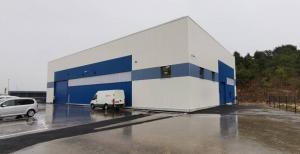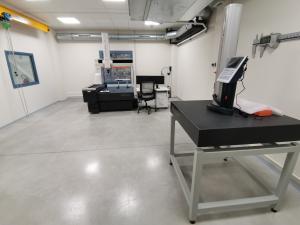Machining workshop opens on site
Construction of an on-site machining workshop began in December 2019 and was completed on schedule in September 2020.
The new workshop will be operated by the DYNAMIC consortium, which was formed to execute one of ITER's two main machine assembly contracts, TAC2 (Tokamak Assembly Contract 2). The consortium reunites Ansaldo Nucleare, Endel Engie, Orys Group ORTEC, SIMIC, Ansaldo Energia, and Leading Metal Mechanic Solutions SL.
TAC2 scope includes complex lifting, positioning, welding and inspection tasks for ITER's toroidal field coils, vacuum vessel sectors, thermal shields and ports. Initial work will take place in the Assembly Hall, before the bulk of the effort is moved to the central Tokamak pit.
Finishing touches on site
The new workshop includes two milling machines (one vertical and one horizontal) and a large CNC (Computer Numeric Control) machine that operates along three dimensions to produce 3D parts. A work area is set aside for welding, with a smoke exhaust and a welding table. A special room is dedicated to metrology, so temperature and humidity can be controlled to avoid skewed measurements. In addition to the shared spaces, the structure includes offices for area managers of the companies in the DYNAMIC consortium.
"Primarily, the workshop will be a space for repairs and retrofitting," says Nicolas Vendeuvre, Contract Responsible Officer for TAC2. "We cannot always do these things directly in the Assembly Hall or in the pit. So part of the work will be done in this new machining workshop."
"We retrofit by taking measurements just before the direct assembly of the components in the Tokamak pit, or in the sector sub-assembly tool in the Assembly Hall. Retrofitting is required, for example, when you try to assemble two components and there is a gap. You need to machine the third piece, called a shim, to fit the exact gap and this is not something you can do before assembly."
Shims will be used for mechanical parts, but they will also be used to make corrections on concrete structures, which are even more prone to misalignment. "Concrete expands and shrinks more than the metal," says Vendeuvre. "And pouring concrete cannot be done within the same final tolerance as you would get with very precise machining operation. The tolerance for placing concrete is +/- 10 mm. But for mechanical parts, and especially for the assembly we need to do in the tokamak, we need much lower tolerances—less than 1 mm sometimes."
Other adjustments can be made in the workshop. Raw materials are often delivered with extra lengths and must be cut at the exact right dimension, as measured on site. It may also be necessary to enlarge holes on one part to connect to one or more other parts. And some pre-assembly will be performed at the workshop—for example, pieces of pipe can be assembled in the workshop before bringing them to the final assembly site.
"The workshop will also be used to build light tools or structures used to support components, pre-assembly works or structures," adds Vendeuvre.
Distance has always been a driving force
"One of our goals was to avoid transporting components off site to the workshops of consortium members," says Vendeuvre, "especially since the nearest is 80 km away from ITER. Having the workshop onsite allows us to avoid the risk of damaging components during transportation and it also saves time and money. This is why the ITER Organization included the onsite workshop as a project requirement."
The 2,000 m² workshop will be operated by DYNAMIC, with around ten people in the workshop at a time.




